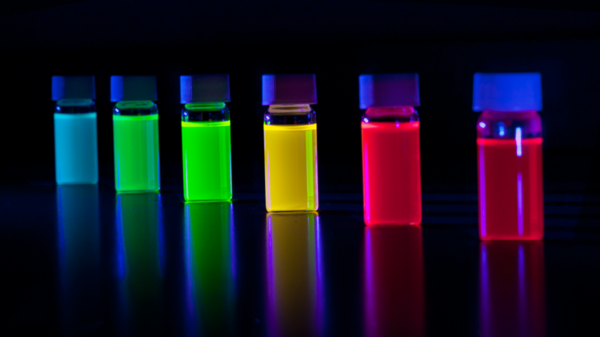A Comprehensive Guide to Quantum Dots
Quantum dots, often abbreviated to QDs, are nanoscale semiconducting crystals characterized by their unique optoelectronic properties. These are defined primarily by the size of the individual crystal; ranging as low as 2 nanometres (nm) in diameter. At such small scales, the properties of materials are increasingly dictated by quantum physics. This is also part of the reason why quantum dots are sometimes described as artificial atoms.
Research and development (R&D) into the production of quantum dots began in the late 1980s, and developers today are still refining the processes involved in applying the technology to current markets. Certain industries have already actualized quantum dot technologies with beneficially disruptive results.
In this article, Avantama aims to answer all your questions about quantum dots and to provide some insight into their growing market viability.

Production of Quantum Dots
Quantum dots can be produced via several distinct fabrication technologies; the most prevalent of which is colloidal synthesis. This is a method of solution processing where precursors decompose in a heated solution and nucleate to form monomers. These anneal in the high processing temperatures, culminating in crystal growth. In order to qualify as nanoparticles, these crystals can be no larger than 100 nm in diameter. Maintaining tight control of the heating parameters throughout production and continuously regulating the solution’s monomer concentration ensures an ideal quantum dot yield with respect to volume and individual geometries.
Additional methods of producing quantum dots include plasma synthesis and electrochemical assembly. Colloidal synthesis is currently the most cost-effective technique with the widest current range of downstream applications. If you would like to know more about plasma synthesis, see our previous blog post: How are Quantum Dots Made?
Avantama has developed its proprietary synthesis method which is the most cost- and solvent-efficient method to date.
Optoelectronic Properties
Quantum dots display unique electronic characteristics that are intermediate between discrete molecules and bulk semiconductors. This is a factor in their ability to emit light via photoluminescence when stimulated by electricity or excitation photons.
The structure of quantum dots is key to this photoluminescent effect: Traditional QDs typically exhibit a core-shell structure with confined valence band holes, conduction band electrons, or excitons. This confinement ensures that quantum dots have a distinct energy level, which defines the band gap between the top of the valence band and the bottom of the conduction band. When excited, electrons jump up to a higher energy band and gradually relax back, losing energy. This loss of energy causes the quantum dot to emit light of a predetermined wavelength.
The emission wavelength is generally determined by the crystal size, but producers are increasingly able to fine-tune the chromatic emission properties of quantum dots by experimenting with novel chemical arrangements.
Applications of Quantum Dots
The potential applications of quantum dots are virtually limitless, but they are currently used to greatest effect in the consumer display market. Quantum dots can be integrated into premium liquid crystal displays (LCDs) with extremely wide color gamut (WCG) capabilities and impressive electrical efficiencies due to their superior quantum yields. Increasingly, quantum dot LCDs are competing with organic light-emitting diode (OLED) televisions to reshape the landscape of the high-end consumer display market.
There are also emerging applications available for quantum dots in photovoltaics and intuitive lighting. Further development is required in these fields.
Quantum Dot Chemistry
One drawback to quantum dot actualization has been the material’s reliance on toxic materials with speculative RoHS exemptions. Increasingly, manufacturers are looking for alternatives to elements like cadmium to future-proof the technology and provide a safe and efficient material for tomorrow’s market challenges today.
Indium phosphide (InP) is often touted as a successor to cadmium as the base chemistry of choice for quantum dot synthesis, but there are new concerns surrounding the toxicity of InP quantum dots too. Novel chemical arrangements are required to overcome these toxicity concerns and ensure RoHS compliance in quantum dot technology going forward.
Avantama: Quantum Dot Suppliers
Avantama is an industry-leading supplier of quantum dots based on metal halide perovskites; a fully RoHS compliant material with superior chromatic properties and negligible toxicity. If you would like to learn more about our quantum dots, simply contact a member of the Avantama team today.